Understanding the Asphalt Paving Process From Start to Finish in Schenectady, NY
Embarking on an asphalt paving project in Schenectady, NY, involves a comprehensive sequence of operations designed to achieve a durable and superior-quality pavement. The initial phase, demolition and removal, clears the site by removing existing surface materials, which is essential for preparing a flawless foundation.
The subsequent steps of grading and sloping are crucial for ensuring optimal water runoff and drainage. Preparing the sub-base, a foundational layer, provides the necessary stability and support for the pavement.
The process then moves to proof rolling, a technique used to identify and rectify any underlying weaknesses in the sub-base, followed by repairs if needed. The application of a binder layer, typically composed of asphalt and aggregate, forms a strong and resilient base for the pavement.
The final pavement structure is completed with the surface course layer, which is designed to withstand traffic and environmental conditions to ensure longevity.
The conclusion of the project involves precise installation techniques and meticulous finishing touches to ensure a smooth, seamless, and enduring asphalt surface. As the project progresses, stakeholders, including homeowners or municipal officials, gain deeper insights into these essential phases and how they integrate to create flawless and lasting pavement.
Demolition and Removal
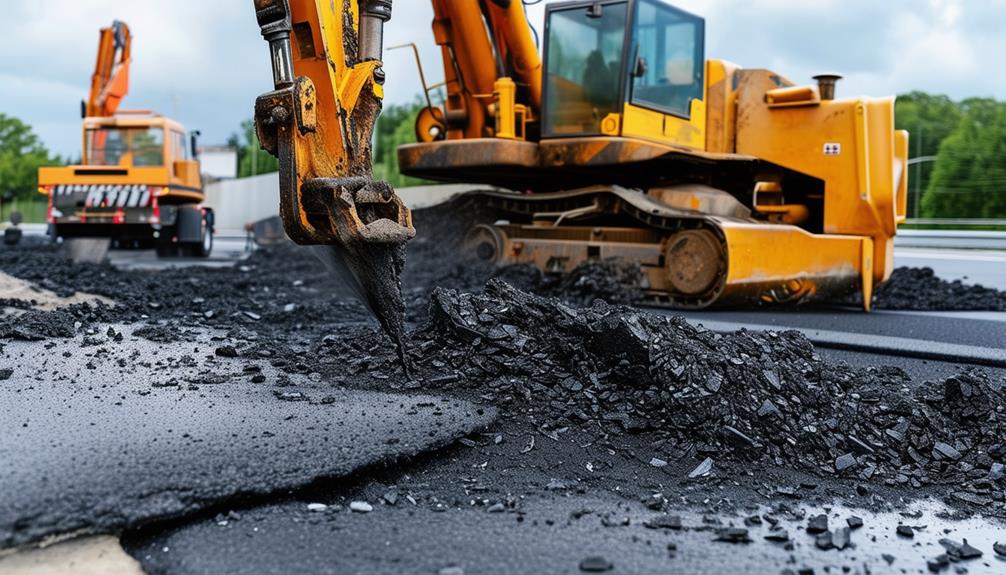
Prior to initiating the construction of your new asphalt driveway or pavement within the confines of Schenectady, NY, it's imperative to execute the demolition and removal of the outdated surface. This step is crucial to establish an immaculate foundation for the impending pavement installation.
You can remain confident in knowing that approximately 100% of the materials eradicated during the demolition phase are recycled, endorsing an eco-friendly approach.
Sophisticated heavy machinery such as compact bobcats, robust forklifts, efficient front loaders, and substantial large dump trucks are enlisted to expeditiously eradicate existing surfaces. This method not only accelerates the process but also facilitates the recycling of old asphalt and concrete at designated asphalt plants, diminishing waste and fostering environmental sustainability.
The act of demolition is essential for ensuring a pristine base for the new pavement installation by dismantling existing structures of asphalt, concrete, or pavers. Furthermore, it readies the sub-base, which furnishes stable support for the forthcoming asphalt pavement. This pivotal process sets the stage for a durable and enduring installation.
Grading and Sloping

Following the demolition and removal of the existing asphalt, the next phase is the grading and sloping of your driveway, crucial for directing water drainage and extending the lifespan of your new asphalt. This vital process mitigates common damages such as potholes and surface cracks, which can significantly deteriorate your asphalt.
The specific grading strategy is customized for each site, accounting for factors such as geographical location and surrounding terrain. Advanced technology, including laser-guided transits and automatic motor graders, is employed to achieve the precise grade percentage necessary for optimal water diversion away from your driveway.
Grading and sloping are critical to preserving the structural integrity of your asphalt pavement. Creating a level or appropriately sloped surface is essential for effective water management, pivotal in averting potholes and fissures. By implementing a deliberate percent grade during the grading process, water is expertly maneuvered away from the pavement, helping to maintain its functionality and aesthetic appeal over time.
Prepare the Sub Base
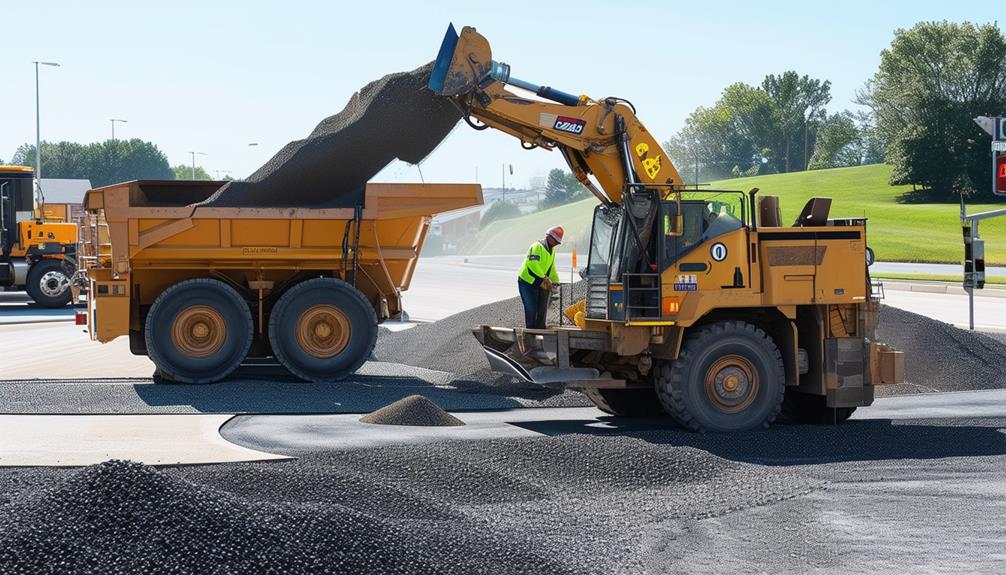
Preparing the sub base is a fundamental process that ensures stable support for new asphalt pavement, serving as an effective frost barrier to mitigate winter damage. This step is critical for the enduring quality of your asphalt surface.
Sub base preparation involves utilizing crushed stones or reclaimed materials to construct a robust base for your pavement. Ensuring adequate compaction of the sub base is imperative for the asphalt's structural integrity. The thickness, stability, and thorough compaction of the sub base are crucial factors in sustaining the lifespan of your pavement.
To secure optimal thickness, the sub base must be precisely graded and leveled. Stability is achieved by eliminating any soft areas and replacing them with more durable aggregate materials. The compaction process should be executed meticulously and uniformly to avert any future settling.
Adhering to these guidelines will confirm that your sub base is well-prepared, laying a sturdy groundwork for your new asphalt pavement. This preparation offers reassurance that your pavement is equipped to withstand the severe winters of Schenectady.
Proof Roll and Repair
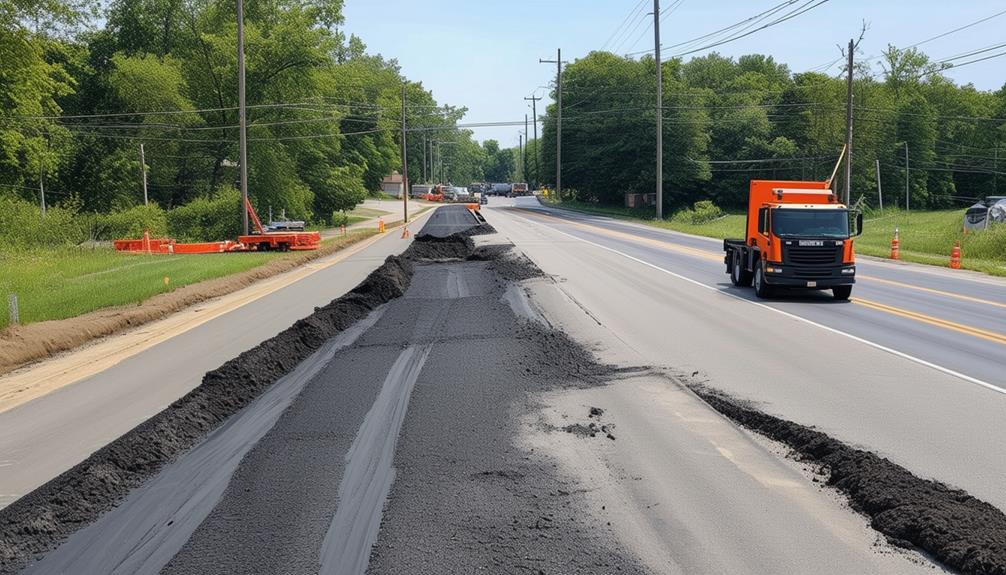
Upon ensuring that the sub base is thoroughly prepared, the next pivotal step involves conducting an exhaustive proof roll to pinpoint any areas requiring reinforcement, which is essential for establishing a robust foundation for the forthcoming asphalt surface.
During this proof roll phase, a fully loaded truck maneuvers across the sub base to identify any soft spots which could undermine the longevity of the pavement.
Areas that exhibit excessive flexure are flagged for subsequent remediation. One effective remedy is the technique of undercutting, which entails excavating beneath the detected weak point to remove substandard sub base materials and substitute them with a stronger aggregate mixture. This method markedly bolsters the pavement's durability.
Another alternative involves the use of geo-grid technology, which provides additional reinforcement and stands as a cost-efficient solution.
Additionally, an innovative remedy called plowing can be employed, wherein soft clay is amalgamated with aggregate to fortify the sub base effectively.
Binder and Surface Course
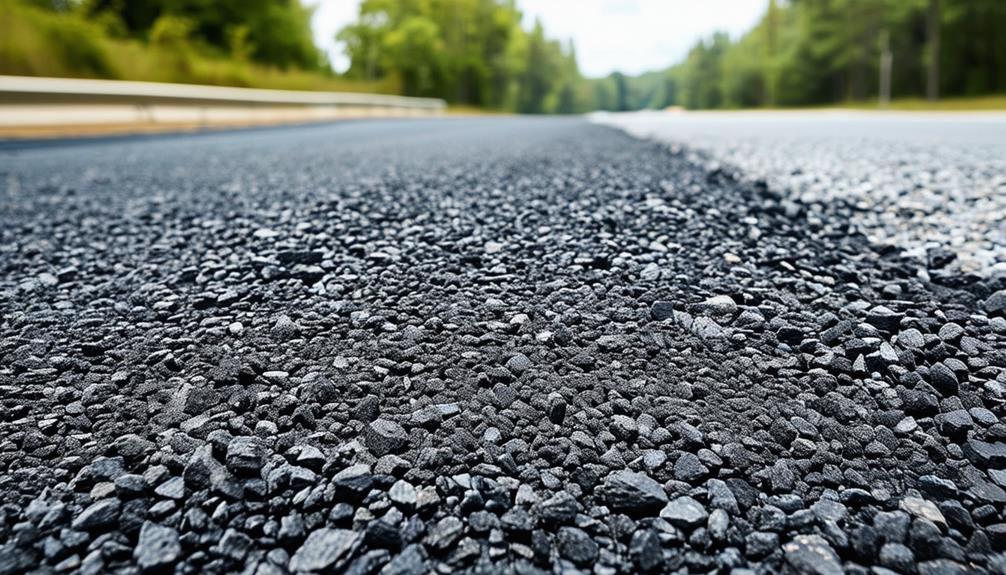
To ensure a robust and climate-resistant asphalt infrastructure, the binder layer must be expertly engineered, integrating substantial aggregates with a precise measure of oil for enhanced durability. This critical phase in the asphalt fabrication sequence grants the pavement its fundamental load-bearing capabilities and resilience against seasonal fluctuations in volume. Absent a meticulously crafted binder layer, the entire structure might be susceptible to fissures and premature degradation.
The binder layer establishes the groundwork for the surface course, which represents the uppermost stratum encountering vehicular traffic. The surface course is tailored to deliver a smooth transportation experience, reduce acoustic disturbances, and enhance visual aesthetics. This is achieved by incorporating finer aggregates into the mix, optimizing the outcome for the asphalt pavement.
Both the binder and surface course strata are pivotal for the longevity and structural integrity of asphalt surfaces. The cohesive bond between these layers ensures maximal abrasion resistance and a steadfast finish, rendering your driveway or parking area a wise investment for the foreseeable future.
Final Installation and Finishing
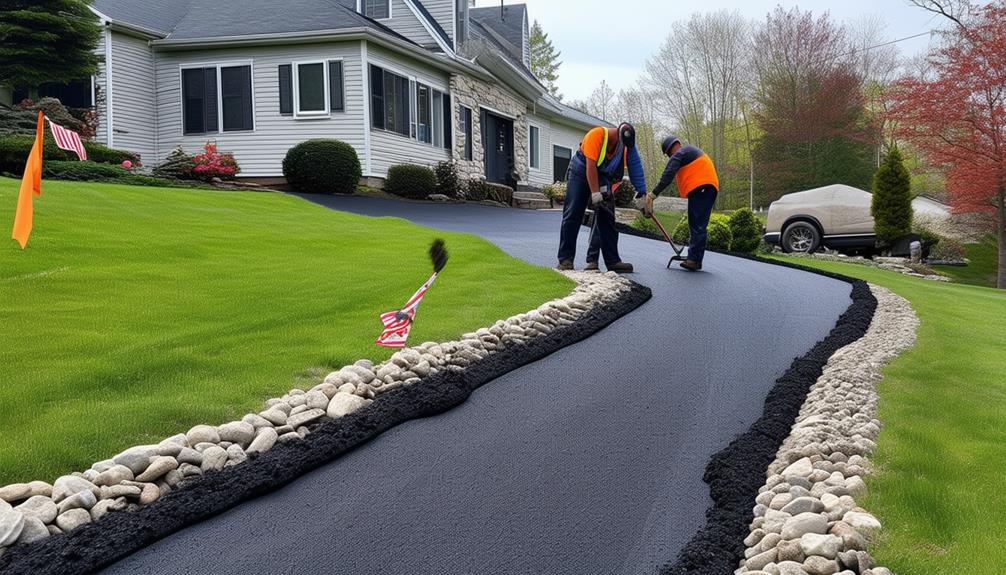
With the binder layer securely in place, the pivotal final phase of the asphalt paving procedure, the installation of the surface layer, requires meticulous precision and keen attention to detail to ensure a smooth, robust, and visually striking roadway. This paramount stage encompasses the deployment of the surface course of asphalt atop the binder layer. It's imperative during this juncture to guarantee the asphalt mix is thoroughly compacted to foster optimal adhesion and extend the lifespan of the pavement.
As you near the conclusion of your asphalt paving endeavor, it's essential to recognize the significance of the finishing methodologies employed. These methods are instrumental in fabricating a seamless and aesthetically pleasing asphalt surface. The final details are crucial in forging a resilient and premium pavement capable of enduring the rigors of weather and consistent traffic over extended periods.
In the city of Schenectady, NY, a place where residents cherish their independence, it's of paramount importance that your asphalt paving task is executed with utmost precision and acute attention to detail. By ensuring the proper application of the final installation and finishing techniques, you're assured of a durable, visually appealing asphalt surface that not only augments the value of your property but also enhances your quality of life.
Frequently Asked Questions
What Are the Steps to Laying Asphalt?
When laying asphalt, commence by preparing the substrate to ensure a robust foundation.
Subsequently, deploy the asphalt material, ensuring precision in its application.
Proceed with the compaction phase to enhance its smoothness and durability.
Implement edge finishing for an aesthetically pleasing appearance, and apply a sealant for additional protection.
Conclude by allowing the asphalt to cure completely, finalizing the process.
What Is the Process of Asphalt Paving a Road?
When initiating asphalt paving for a road, meticulous preparation is essential. Begin by clearing the designated area and utilizing specialized paving machinery to grade and stabilize the sub-base.
Subsequently, apply a robust binder layer comprised of asphalt cement, which acts as a glue to hold the aggregate particles together. Next, introduce high-quality materials to construct a durable wearing course – the top layer of the roadway.
Complete the process by creating a smooth, even surface and implementing precise road markings for safety and navigation. To ensure long-term durability, it's vital to adhere to a regimen of consistent maintenance practices.
Additionally, consider the environmental implications of your paving endeavor by selecting sustainable materials and methods to minimize ecological impact, ensuring the project is both efficient and environmentally responsible.
What Is the Best Time of Year to Lay Asphalt?
When determining the optimal period to install asphalt, it's crucial to factor in climatic conditions and ambient temperatures that influence the paving operation. Ideal temperature thresholds span from 50 to 90 degrees Fahrenheit, facilitating adequate curing.
It's advisable to steer clear of precipitation or excessively high temperatures to ensure optimal bonding and compaction of the material.
The spring and summer seasons in Schenectady, NY, provide extended daylight periods, allowing for continuous labor which contributes to attaining a seamless and robust roadway surface.
What Are the Layers of a Paved Driveway?
When constructing a paved driveway, it's essential to comprehend the various layers that ensure durability and functionality. The foundational base layer offers structural stability, essential for long-term usability.
Positioned above this, the intermediate layer contributes additional strength, critical for supporting the weight of vehicles. The topmost surface layer, which ultimately receives the seal coating, is the visible and functional component where vehicles will travel.
Key elements such as proper compaction, effective drainage systems, and robust gravel bases are integral to the longevity of the driveway. Additionally, factors like climatic conditions should be considered to tailor the construction and maintenance strategies, ensuring both residential and commercial driveways efficiently withstand time and usage.
Regular upkeep and maintenance align with budgetary allocations are advisable to maximize the functional lifespan of the driveway.
Conclusion
Understanding the Asphalt Paving Procedure from Start to Completion in Schenectady, NY
Demolition and Clearance
The existing pavement layer, be it asphalt, concrete, or paving stones, is dismantled using robust equipment such as forklifts, front-end loaders, and heavy-duty dump trucks. Subsequently, debris is cleared away, and materials such as old asphalt and concrete are usually repurposed through recycling processes.
Surface Leveling and Drainage Optimization
Advanced technology, including laser-guided transits and automated motor graders, is employed to accurately grade the surface to facilitate optimal water runoff and prevent pooling.
Sub Base Preparation
Construct a stable and frost-resistant sub-base by incorporating crushed aggregate material and thoroughly compacting it to provide a firm foundation for the new pavement.
Integrity Testing and Enhancement
Perform an integrity examination by rolling a fully-loaded truck over the base to identify any underlying weaknesses. Areas revealing subsidence are meticulously excavated and reconstructed to ensure uniformity before proceeding.
Application of Binder and Top Layer
A binder layer, consisting of an asphalt mix amalgamated with oil, is first applied, followed by the top layer. The surface course addition furnishes a smooth, resilient finish to the pavement.
Final Installation and Surface Refinement
Lay down the new asphalt, making certain it's evenly distributed, meticulously smoothed, and thoroughly compacted to achieve an optimum level of durability and structural integrity.
Summary:
The end result is a uniformly smooth, new asphalt surface. To extend its lifespan, adhere to rigorous maintenance and prompt repair protocols.
